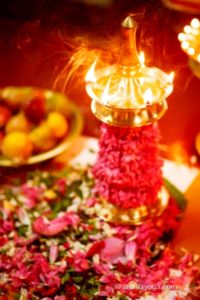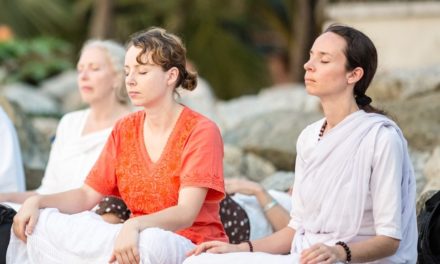 Among the many festivals of our country, Navarathri has a very important place. This is the time we offer a special puja to our universal mother, Adi Parashakthi.
Among the many festivals of our country, Navarathri has a very important place. This is the time we offer a special puja to our universal mother, Adi Parashakthi.
Even though thereare Goddesses in Greek, Roman, Egyptian and Chinese worship, it is only in Sanatana Dharma that the Goddess is worshipped as the Supreme Being, Adi Parashakthi. There are not many goddesses in Sanatana Dharma – One Supreme Parashakthi appears in many forms.
All the forms in this universe manifest from her, through her maya shakti, including Brahma, Vishnu and Shiva, along with their Divine Consorts, Saraswathi, Lakshmi and Parvathi.
During Navarathri we worship the Divine Mother in her main three forms –Durga, Lakshmi and Saraswathi.
The first three days, we worship her as Durga, who removes all our obstacles, destroys our enemies, both external and internal (in the form of negative qualities, negative thoughts and habits).
The second three days, we worship the same Universal Mother in the form of Mahalakshmi who gives us wealth, both material and spiritual, along with the divine qualities like compassion, humility, patience, cheerfulness, etc., which is the real wealth that makes us happy.
The last three days, we worship the same Universal Mother in the form of Mahasaraswathi who bestows on us the
knowledge, intelligence and wisdom, both material and spiritual, to lead an ideal human life and finally merge into Her Lotus Feet.
On the eighth day, Durga Ashtami, we place our books and different instruments we use everyday at the sacred feet of the Divine Mother and pray to her to purify them.
On the 10th day, Vijayadasami, we take them back. This is called Ayudha Puja, literally meaning ‘puja for the instruments’. It is like servicing a vehicle and taking it back.
The symbolic meaning: we remember that all our instruments, including our ten organs, body and mind, are blessed and energized by the Divine Mother, without whose grace none of these can function.
On this 10th day, Sri Rama had killed Ravana, who is Dashamukha (ten-faced), representing the five organs of knowledge and five organs of actions, symbolizing that the blessing of Sri Rama enables us to control all our ten organs.
On the 10th day of Vijayadasami is Vidya Arambham (start of knowledge). This is when parents bring their children to their respective Gurus, who initiate the children into the study of alphabets—the beginning of education.
The alphabets are called aksharas. When the Guru starts Akshara Abhyasa or the teaching of akshara (alphabets), he keeps in mind that he ultimately has to teach the disciples the Real Akshara—the knowledge of God, the Imperishable Truth; that Akshara, which alone can take one to Eternal Peace. God alone can give us infinite peace and joy.
One who has the knowledge of akshara is Saakshara. One, who does not have it, is a Rakshasa (demon). Ravana, who was a very learned Saakshara, was a Rakshasa. This is because he did not have the full knowledge of God. Therefore, education is complete only when we have complete knowledge of God.
Navarathri which means ‘nine nights’ consisting of the worship of the Divine Mother also has another meaning. Nava also means ‘new’. So Navarathri also means ‘New Nights’. Usually, nights are spent in enjoyment and rest.
Man carries the feeling that: “With my intelligence, strength, and efficiency, I have earned money and I am enjoying!” This is wrong notion. Navarathri is an opportunity to remember that everything we have is only because of the grace and the blessings of the Universal Mother.
Kali Mata wears a garland of human skulls, which symbolizes that all “heads” (i.e. knowledge) belongs to her and comes from her. She also wears a skirt made of human hands. Hands represent actions. This symbolizes that all power, strength and actions belong to her.
Some ask why our Goddess Kali drinks blood or why we offer blood to her. This is only symbolic. Blood represents strength in every living being. “All strength belongs to me,” she says. We wear Kumkum (which is red in colour) on our forehead to remember that all strength belongs to her!
She is called Shmashana Vasini (‘one who lives in graveyard’). After death, all our relatives and friends go back, but Kalima is always with us.
Some ask as to why Mother Kali does not wear an upper garment. Kalima not wearing any upper garment indicates her Infinite Expansive Nature. Her body is vast, like space. Her body is either blue or black. Space is blue during the day and black during the night.
Her uncovered breasts represent her ever-readiness to give. She is impatiently waiting to give her children her milk, which is material prosperity and spiritual wisdom… enlightenment – ‘Bhukti Mukti Pradaatha’.
We are only babies in her infinite presence. Let us worship the Divine Mother with this proper understanding.
Let us feel blessed, energized, and peaceful. Let us pray that she makes us an ideal human being and take us to the ultimate purpose and goal of human life –Liberation.
Author: Swami Amritageetananda Puri




